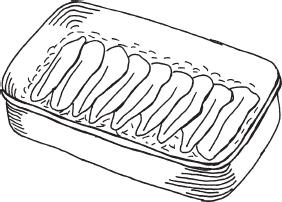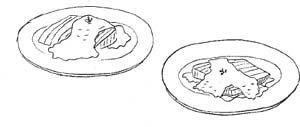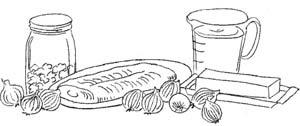Authors: Sally Fallon,Pat Connolly,Phd. Mary G. Enig
Tags: #Non-Fiction, #Reference, #Science, #Health
Nourishing Traditions: The Cookbook That Challenges Politically Correct Nutrition and The... (77 page)

Variation: Filets of Sole with Portuguese Sauce
In addition to the basic ingredients, you will need
two ripe tomatoes
, peeled, seeded and chopped. (To peel tomatoes, see
Kitchen Tips & Hints
.) Strew them in the pyrex pan with the onions. When you transfer the stock to a frying pan for reduction, do not strain out the onions and the tomatoes. Let them reduce with the sauce. Don't forget the chopped parsley—it looks so pretty with the tomatoes.
Variation: Filets of Sole with Vegetables
Prepare the basic recipe. When the sauce has reduced to the desired thickness, stir in a julienne of vegetables made in the following manner:
Peel
1 small carrot
and cut into thin strips, approximately
1
/
8
inch by
1
/
8
inch by 1 inch long; cut the skin off
1 zucchini
and cut this skin into similar strips. (Save the pulp for soups.) Remove the end and leaves from
1 leek
and slit lengthwise half way through. Rinse clean under the tap. Cut rounds about
1
/
8
inch thick. (The rounds will open and separate when cooked, forming julienne strips.)Bring a pan of salted filtered water to a boil. Put the carrots in a strainer, hold down in the boiling water for about 1 minute, then rinse with cold water. Strew onto a plate lined with several thicknesses of paper towels and pat dry. Repeat the process with the zucchini strips and the leeks. Mix vegetables together and add to sauce.
Variation: Filets of Sole with Pink Grapefruit Sauce
This is an easy variation with a beautiful presentation, yet worthy of the most elegant dinner party. Prepare the basic recipe, adding
½ cup fresh grapefruit juice
to the sauce.Prepare individual plates with the following garnishes alternating around the outer edge of the plate:
sections of pink grapefruit, steamed Chinese peas
, and spoonfuls of
fresh tomato, peeled, seeded and finely chopped
. (To peel tomato, see
Kitchen Tips & Hints
.) Place filets in center of plate, pour sauce over and sprinkle on a small amount of
finely chopped parsley
.
One of the earliest warnings about the rising tide of sugar in our diet came from that 1942 AMA report: "The consumption of sugar and of other relatively pure carbohydrates has become so great during recent years that it presents a serious obstacle to the improved nutrition of the general public." In the strongest terms possible, the report called for "all practical means to be taken to limit consumption of sugar in any form" in which significant nutrients are not present. . .. It was a call unheeded. From the end of wartime rationing to the present, the food industry has known no limit, beyond the technical, in using sugar to cheaply enhance the appeal of its processed and fabricated foods. In these last 40 years industry has more than doubled the sugar it adds to our diet. But protests are no longer heard—the watchdogs of the public's welfare appear to have been pacified.
In the mid 1970's the blue-ribbon FASEB (Federation of American Societies for Experimental Biology), on contract to the FDA, wholeheartedly recommended the agency again approve sugar as a food additive, saying that with the possible exception of dental caries sucrose presents
no
risk to human health. Joseph D. Beasley, MD and Jerry J. Swift, MA
The Kellogg Report

Organ weight studies have shown over and over again that poor nutrition profoundly disturbs the weight of most of the endocrine glands (such as the pituitary, thyroid and pancreas) as well as many organs. Obesity is accompanied by profound changes in endocrine and organ weights. Obesity
per se
is only the visible aspect of hidden and far more serious pathological conditions. In Dr. Marshall's mice, the liver became greatly enlarged, while the heart, kidneys, and pancreas also became enlarged. There is strong evidence recorded in the periodical literature that heavy use of refined sugar causes pituitary lesions and perhaps brain lesions. Edward Howell, MD
Enzyme Nutrition
DINNER IN THE FRENCH STYLE
Pickled Gherkins
Filet of Sole with Cream Sauce
Red Potatoes
Steamed in a Clay Pot
Steamed
SALMON WITH BUTTER SAUCE
Serves 6
2 pounds filet of wild salmon
4 cups
fish stockseveral sprigs fresh tarragon
½ cup butter, softened
1 tablespoon fresh tarragon leaves, snipped
1 teaspoon vinegar
Butter a small oblong pyrex dish and set the filet, skin side down, in the dish. Strew with tarragon sprigs. Bring the stock to a boil and pour over the filet. If the liquid does not entirely cover the fish, add filtered water. Set in a 325-degree oven and poach until just tender, from 10 to 15 minutes depending on the thickness of the filet. You can check for doneness with a fork. Be careful not to overcook. Remove from the oven when the inside is still a little rare. Set the filet on a heated platter, cover with a piece of parchment paper (See
Sources
), and keep in a heated oven while you prepare the sauce.Pour stock into a heavy skillet and boil vigorously until it reduces to about 1 cup. Allow to cool slightly. Pour cooled stock into a bowl set in barely simmering water. Using a wire whisk, add the butter to the stock, 1 tablespoon at a time, beating vigorously with each addition. Stir in vinegar and tarragon snippings. Do not let the sauce boil. When all the butter has been amalgamated, check for seasoning. Salt will probably be unnecessary. Divide the filet into servings and place on individual plates. Spoon a little sauce over each and serve immediately.
No wonder there is so much chronic and metabolic disease in America today. In order to deal with all the pollutions and stresses of modern living, healthy bodies must have strong, healthy cells. The key to strong, healthy cells lies first in the cell membrane. Human cell membranes are made of a remarkable combination of fatty acids and proteins—with fatty acids the dominant material. When this man-made molecule of fatty acid, called the
trans
fatty acid, gets into cell membrane construction our cells cannot function optimumly—we cannot ward off viruses as well; the vital biochemical exchanges going on between the interior and exterior of our cells can be fouled up; and our cellular oxidation cannot be as robust as nature intended. Additionally, this degeneration of the cell membrane is cumulative as we continue to eat these
trans
fats every day—it doesn't improve over time, or simply vanish, it slowly gets worse and worse. And the rottenest thing about this entire story is that this molecular misfit, the
trans
fatty acid, is generally hyped by colorful and clever advertising to be "good for you." How in the world did this happen? How did a man-made molecule of very bad fat become a major part of everyday nutrition and get a reputation for being good? Encouraged by our mass media, we took ourselves off butter and stopped cooking with lard and bought margarines and vegetable shortening because we were told it was the "healthy thing to do." And it's not true. It's the opposite—and the money power behind the promotional campaign knew it! They had to know it. Tom Valentine
Facts on Fats & Oils

SALMON WITH SUN-DRIED TOMATO SAUCE
Serves 4
1 filet of wild salmon, about 1
1
/
3
pounds2 cups
fish stock3 tablespoons butter
8 shallots, finely chopped
4 tablespoons sun dried tomato bits (See
Sources
)sea salt or fish sauce (
Fermented Fish Sauce
) and pepper
Butter a small oblong pyrex dish and set the filet, skin side down, in the dish. Bring stock to a boil and pour over the filet. If the liquid does not entirely cover the fish, add filtered water. Set in a 325-degree oven and poach until just tender, from 10 to 15 minutes depending on the thickness of the filet. You can check for doneness with a fork. Be careful not to overcook. Remove from the oven when the inside is still a little rare. Set the salmon on a heated platter, cover with a piece of parchment paper (See
Sources
), and keep in a heated oven while you are preparing the sauce.While the salmon is cooking, saute shallots a few minutes in butter, add the tomato bits and cook a few minutes more. After the fish has poached, strain stock into the shallot mixture, bring to a rapid boil and reduce the stock, skimming occasionally, until you have about a cup of liquid plus vegetables. Season to taste.
To serve, portion the fish and lift off the skin. Divide among four heated plates and spoon on the sauce.
Two recent studies have confirmed what Weston Price discovered over 60 years ago—that seafood makes a vital contribution to good health. A study conducted in Britain found that middle-aged men, who had already suffered a heart attack, cut their death rate by one-third by adding oily fish like salmon, tuna, mackerel and sardines to their diet. In the study of 2,033 men under age seventy, researchers told one group of men to eat fish high in omega-3 oils at least twice a week; another group was told to cut down on high-fat foods; another to eat more fiber; and a fourth was given no dietary advice. After two years the odds of dying of heart disease dropped by 29 percent among the fish eaters compared with the other men in the study. In Japan, a series of studies has shown that those who consumed lots of seafood were much less likely to die of strokes. Residents of fishing villages who eat about nine ounces of seafood daily have a 25 to 40 percent lower risk of stroke than farmers who eat only three ounces of fish a day. SWF


